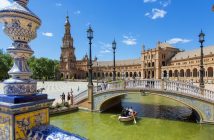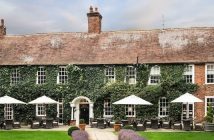I had a surprise for Mrs L on her birthday. “Are we going shopping?” she asked, as our taxi inched us towards Oxford Street. Au contraire. I asked the driver to alight just behind Tottenham Court Road tube station and we turned down a less than salubrious back alley, past industrial dumpsters and low-lit doorways. “Not quite the surprise I had in mind,” she declared. But this was to throw her off the scent. Within moments we had turned a corner and we could have almost entered a time portal.
“Oh, wow,” was her next impression. And here we were, back in time, staring up at The Bloomsbury’s inviting façade, Sir Edwin Lutyens’ magnificent 1928 masterpiece.
Think of London’s Bloomsbury neighbourhood and you think of Virginia Woolf, Keynes, Forster, Lytton Strachey. You think creatives, thinkers, bohemians in beards and shapeless dresses, sipping lethal cocktails and intellectualising over a new world order in their own secluded enclave. We had stepped into an era at the heart of one of London’s literary and artistic legacies.

Fittingly, the suite is equipped with reading material that carries the area’s heritage. Sure, there are the token luxury magazines – perhaps even the definitive: a boxed edition of Vogue’s The Gown (with a gentle request inside to take the toiletries instead!) – but there’s bespoke bedside reading, too; a history of the hotel and a short profile on the poet portraits in the library, books on artists, designers, fashionistas. Bloomsbury by name, Bloomsbury by nature, it seems.
Obviously I post-date some of the hotel’s revered guests, but there’s something of the spirit of them present, captured by the hotel’s décor. I don’t doubt the dark wood-panelled basement bar saw plenty of late night discourse over absinthe and proof-strength gin in its day, the vibrant rustic-themed wallpaper in the lobby lounge evocative of one of Virginia Woolf’s block print dresses,  and of course the ever-booked Dalloway Terrace, the site of many a sipped afternoon tea, the strains of 1930s civility giving way to a more relaxing breakfast experience these days.
and of course the ever-booked Dalloway Terrace, the site of many a sipped afternoon tea, the strains of 1930s civility giving way to a more relaxing breakfast experience these days.
But it was our suite that captured the essence of our time-travelling adventure, itself showcasing the extensive refurbishment the hotel’s undertaken recently. Nowhere else could you get away with such a deep blue-grey on the walls, and a headboard that’s less a statement, more a tour de force. Crimson padded leather with a richly embroidered trim, it’s the size of the wall behind it. It’s not design for design’s sake, though; it’s geared towards the experience. Indeed, as much as the British Museum is around the corner, and Oxford Street shopping is a stone’s throw away, the room is designed to keep you in it.
And there’s a finesse that goes beyond the functional; the lighting, not normally noticed, is most certainly worth a mention. Never mind that the room’s lights can be operated bedside – a need few hotels fail to master – but that when they turn on they fade to brightness allowing for a gradual acclimatisation. This, reader, is not simply a gimmick. From someone who has had many a poor experience, even in top hotels, to have lighting that is almost behavioural is worthy of mention.
The old embraces the modern, too; a massive flatscreen TV is poised to angle to the bed, giving a cosy, pillow-bound cinematic experience, a second sits in the marble-encased bathroom – itself like stepping into a black and white film – above the rolltop tub. If decadence was the buzzword for the design, should I mention I was late for dinner for having been sipping champagne while watching Strictly Come Dancing from a blazing hot bath?

And so to dinner.
The Coral Room is the newest expression of the hotel, pimping its decadent Art Deco heritage. Stunning Murano glass chandeliers grace the 18ft ceiling and the Calacatta marble top bar, leather backed stools and palm fronds in the comfy corner banquettes give the feel of sipping cocktails less in a London bar than in a luxurious ocean liner.
Its name harks to the vivid coral pink lacquer its painted in – a favourite colour of Lutyens’, I’m told. Imagine, double height floor-to-ceiling flamingo. If it wanted to be noticed on the London bar scene, it’s certainly done that. Less a quiet dinner – better Dalloways if that’s the intent – more painting the town pink, the cocktail selection is as extensive as it is inventive and the small plates to share match its decadence with lobster mac cheese, truffle fries and pulled pork sliders.

The night we stayed it thronged but never felt crowded; the Saturday evening patrons dipping in for a livener before a night out or settling for a nightcap before home. We took our spot, in the quietest place we could muster to escape the anachronistic thump of bass just a tad too loud for standard conversation. But it mattered not, we were, for an evening, taken away. I sat, sipping a ‘Barbour and Barrel’, admiring the specially-commissioned works by illustrator-of-the-moment Luke Edward Hall, pondering the area’s history and notoriety, delighted to be joining their like.
Had they dined here, I’m sure Strachey et al might have been suitably sated, literally and figuratively. A night at The Bloomsbury prompts thought, indulgence, a hark back to a halcyon era, and a cracking spot for a birthday away.
Rates at The Bloomsbury start from £295 on a bed and breakfast basis. The Coral Room is open Sunday-Thursday from 8am-midnight and Friday and Saturday 8am-1am. For more information, visit www.doylecollection.com.




